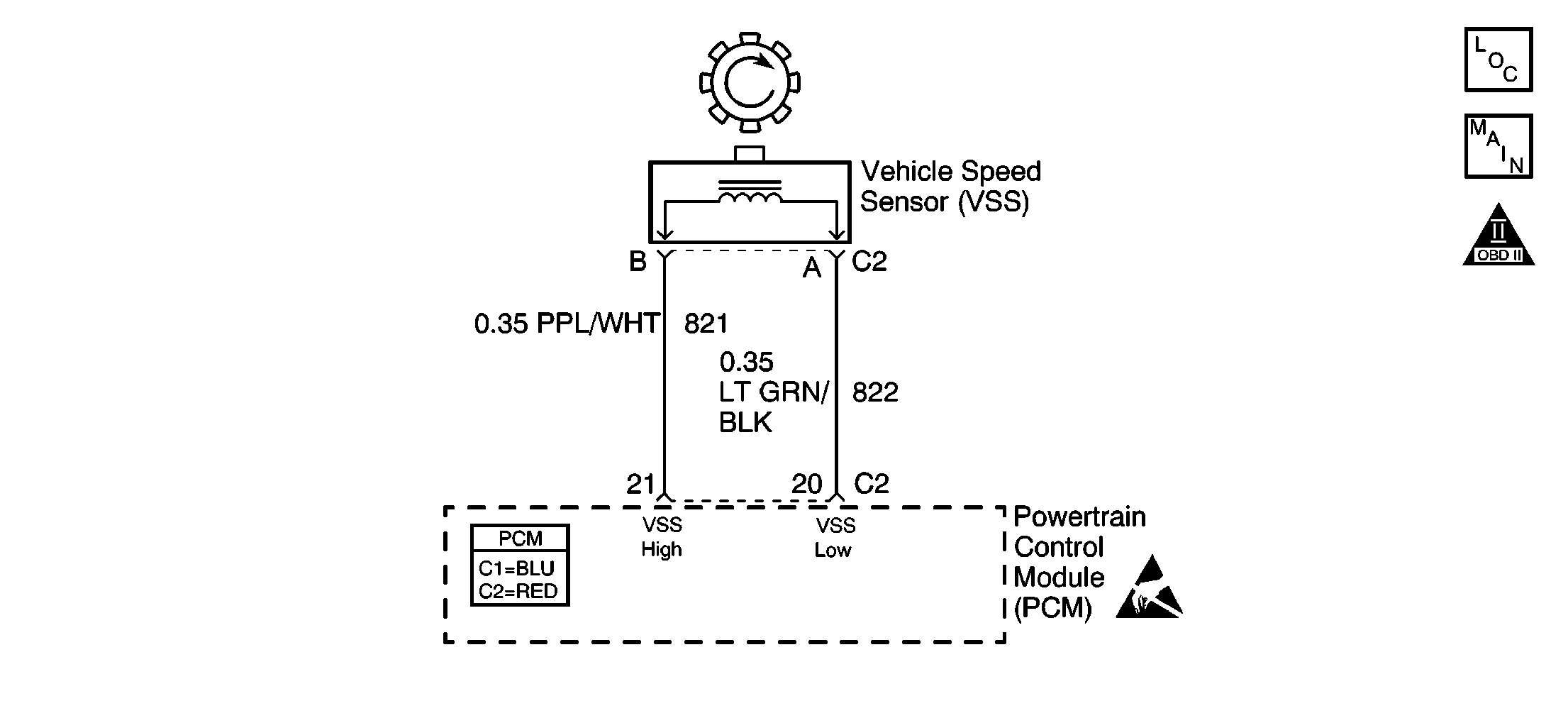
Circuit Description
A toothed wheel mounted on the output shaft of the transmission generates an AC voltage pulse as it moves past the Vehicle Speed Sensor (VSS). The VSS contains a permanent magnet surrounded by a coil of wire, which produces a magnetic field. The toothed wheel interrupts the magnetic field that generates an AC voltage pulse. As the vehicle speed increases the AC voltage pulse rate also increases.
Conditions for Running the DTC
| • | DTCs P0107, P0108, P0117, P0118, P0121, P0122, P0123, P0125, P0506, P0507 are not set. |
| • | The engine coolant temperature is more than 35°C (95°F). |
| • | The engine speed is more than 1,000 RPM. |
| • | The TP sensor angle is between 5.0 percent and 100 percent. |
| • | The MAP is between 40 kPa and 100 kPa when the A/C is OFF. |
| • | The MAP is between 45 kPa and 100 kPa when the A/C is ON. |
| • | All conditions met for 2 seconds. |
Conditions for Setting the DTC
The PCM detects vehicle speed at 0 km/h (0 mph) for 100 seconds.
Action Taken When the DTC Sets
| • | The PCM illuminates the malfunction indicator lamp (MIL) on the second consecutive ignition cycle that the diagnostic runs and fails. |
| • | The PCM records the operating conditions at the time the diagnostic fails. The first time the diagnostic fails, the PCM stores this information in the Failure Records. If the diagnostic reports a failure on the second consecutive ignition cycle, the PCM records the operating conditions at the time of the failure. The PCM writes the conditions to the Freeze Frame and updates the Failure Records. |
Conditions for Clearing the MIL/DTC
| • | The PCM turns OFF the malfunction indicator lamp (MIL) after 3 consecutive ignition cycles that the diagnostic runs and does not fail. |
| • | A last test failed, or current DTC, clears when the diagnostic runs and does not fail. |
| • | A history DTC clears after 40 consecutive warm-up cycles, if no failures are reported by this or any other emission related diagnostic. |
| • | Use a scan tool in order to clear the MIL and the DTC. |
Diagnostic Aids
Important:
• Remove any debris from the PCM connector surfaces before servicing
the PCM. Inspect the PCM connector gaskets when diagnosing/replacing the PCM.
Ensure that the gaskets are installed correctly. The gaskets prevent
water intrusion into the PCM. • For any test that requires probing the PCM or a component
harness connector, use the J 35616
connector test adapter kit. Using this kit prevents damage to
the harness/component terminals. Refer to
Using Connector Test Adapters
in Wiring Systems.
For an intermittent, refer to Symptoms .
Test Description
The numbers below refer to the step numbers on the diagnostic table.
Step | Action | Value(s) | Yes | No |
|---|---|---|---|---|
1 | Did you perform the Powertrain On-Board Diagnostic (OBD) System Check ? | -- | ||
Does the scan tool indicate a vehicle speed above the specified value? | 0.0 mph (0.0 km/h) | Go to Diagnostic Aids | ||
3 |
Does the scan tool indicate a vehicle speed above the specified value? | 0.0 mph (0.0 km/h) | ||
4 | Repair the faulty VSS connection or faulty VSS. Is the action complete? | -- | -- | |
5 | Measure the voltage from the VSS signal circuit to a known good ground using the DMM. Does the DMM indicate the specified value? | 5.0 V | ||
6 | Measure the voltage from the VSS signal circuit to the VSS ground circuit using the DMM. Does the DMM indicate the specified value? | 5.0 V | ||
7 | Check the calibration ID for the most current and/or incorrect calibration. Is the most current and proper calibration present? | -- | ||
8 |
Important:: Program the replacement PCM. Refer to Powertrain Control Module Replacement/Programming . Replace the PCM. Is the action complete? | -- | -- | |
9 | Repair the signal circuit to the vehicle speed sensor. Refer to Wiring Repairs in Wiring Systems. Is the action complete? | -- | -- | |
10 | Repair the ground circuit to the vehicle speed sensor. Refer to Wiring Repairs in Wiring Systems. Is the action complete? | -- | -- | |
11 | Install proper calibration and/or most current. Is the action complete? | -- | -- | |
12 |
Does the scan tool indicate that this test ran and passed? | -- | ||
13 | Select the Capture Info option and the Review Info option using the scan tool. Does the scan tool display any DTCs that you have not diagnosed? | -- | Go to the applicable DTC table | System OK |
